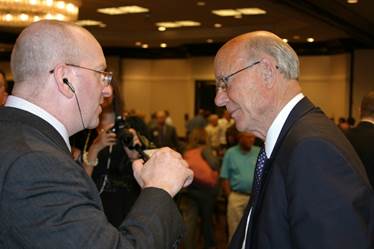
While a Texas A&M University student, Don Atkinson (First Oklahoma Ag, Voice of Southwest Agriculture (VSA) and Yancey Ag Network, Oklahoma City, OK) had nearly 10 years of broadcasting experience under his belt when the on-campus office of the Extension Service hired him. Previously, he had worked as a disc jockey, news writer, copy writer and producer. Working in the Texas A&M radio-television unit, Don helped write and produce a weekly agricultural radio show for two years. (A few years before Don’s tenure at Texas A&M in the late ‘80s, this editor was the radio-TV specialist who created that weekly radio service in the early ‘70s.) In 1992, Roddy Peeples (Emeritus Member, Dallas, TX) hired Don for a job at the VSA Radio Network in San Angelo, TX. Starting as the market director, Don worked his way up to hosting the Midday Farm and Ranch Report in 1995.
In 2001, he was promoted to network anchor and moved from San Angelo to Oklahoma City. A voting member of NAFB since 1992, Don served as South Region Vice-President from 2000-2002. As a farm broadcaster, Don has a strong background. While not raised on a farm, he grew up around agriculture. His grandfather and two uncles were Texas cotton and peanut farmers, another grandfather started a butcher shop and turned it into the biggest meat processing and distribution company in Bryan, TX. Trained as a journalist and mentored by Roddy Peeples and Mike Dain (First Oklahoma Ag, Oklahoma City, OK), Don was named 2003 South Region Farm Broadcaster of the Year. Don believes that coming into farm broadcasting as an “outsider” has helped him ask better questions about agriculture because he didn’t already know the answers. Don is among those broadcasters who started editing radio stories on ¼-inch audio tape with a razor blade and white grease pencil. About the weather in Oklahoma, Don reports April and May rains have made the soil so saturated that current rains are running off and causing flooding. Besides being one of the wettest Aprils since 1895, the state’s temperatures are warmer than normal, too.
